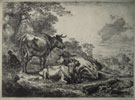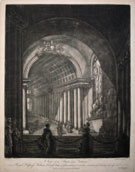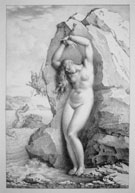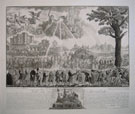|
Humanities and Social Sciences Library > Collections > Print Collection > Recent Acquisitions: Old Master Prints Artists A-D
This drawing appears to be a preparatory sketch for Stefano della Bella’s etching of the colossal statue of the Apennines from his suite of six prints, Views of the Villa of Pratolino. It does not precisely match the etching, and the directness, freedom, and spontaneity with which the artist approaches his subject reinforce the attribution to Stefano della Bella himself. Included in this drawing in the left foreground, but omitted in the subsequent etching, is a delightful vignette of an artist sketching the fountain. The Library has a first state of the print in the Print Collection’s rich holdings of della Bella’s etchings, as well as a second state in the Spencer Collection.
The Library already had a fair impression of this print, one of several in the collection by Nicolas Berchem, a prolific Dutch painter-printmaker best known for his Italianate views and animal subjects. This, however, is a counterproof of that image, made by running a blank sheet of paper through the press against a freshly printed, still wet impression. The etching is transferred, but in reverse, onto the blank sheet. A counterproof is often rather pale; this one is not, suggesting that it was pulled from an early, richly inked impression. The counterproof offers an easily comprehensible demonstration of this printmaking process, while it retains the subtleties of Berchem’s bucolic print, deeply etched in the foreground but minimally etched in the background to convey atmospheric perspective.
A painter and skilled draughtsman, Gerrit Claesz. Bleker made fourteen etchings of biblical and pastoral subjects (the collection previously had only two prints by Bleker, one a very weak impression). His bucolic scenes of cattle and country settings often hid biblical stories, but by the 1640s he seems to have dispensed with religious and literary allusions in his scenes of Dutch rural life. However, in his early The Raising of Lazarus Bleker does not disguise the biblical subject, which he presents in the “primitive” style that a number of Haarlem etchers adopted around 1618 through the 1620s. The protagonists, who gesture dramatically, are arranged in a hieratic scheme and are defined by simple parallel and cross-hatched lines that emphasize their weight and mass. The expressively awkward figures make apparent that this event, Christ bringing Lazarus back to life, is a miracle.
In this series of prints, all superb impressions in excellent condition, etched by his son Cornelis, Abraham Bloemaert is working within an already existing tradition of the pastoral theme in Netherlandish literature and art. Here, the shepherds, soldiers, peasants, and peddlers are accompanied by moralizing messages. While some of the inscriptions below each scene, provided by Hendrik de Roij, city physician of Utrecht and a nephew of Abraham Bloemaert’s second wife, lecture on laziness and gluttony, most, as stated in the title plate, praise the value of leisure “which restores tired limbs with new strength and provides delight and makes us fit for work.” All reflect the common practice in 16th- and 17th-century northern art to inject religious or moralizing themes into a seemingly secular subject. In one of the plates Bloemaert even includes a vignette of Tobias and the Angel, who appear somewhat incongruously to have wandered into a 17th-century Dutch landscape.
Georges-François Blondel, the son of Louis XV’s architect, Jacques-François Blondel, executed only thirteen prints, most of them architectural subjects, and all extremely rare. According to scholar and print dealer Paul McCarron, Blondel was raised in Paris and traveled in the 1750s to Rome. There he made the sketches that were the basis of most of his later prints. He was aware of Piranesi, whose etched architectural subjects, though influential, were transformed by Blondel into “mysterious and haunting images of great intensity” through his mastery of mezzotint, a process that requires working from dark to light. The image is made by scraping the textured surface of a plate that has been evenly roughened to print black where not burnished. The smooth areas do not hold ink and appear as highlights. Blondel also created set designs in Amsterdam, and lived for a time in England, where he exhibited his architectural mezzotints. He returned to Paris in 1790 and disappeared during the Revolution, after proposing decorations for the Festival of the Federation.
Giulio Bonasone was a prolific Bolognese reproductive engraver, working in the tradition of Marcantonio Raimondi. However, Bonasone also etched a handful of imaginative prints after his own designs, including the Triumph of Cupid and Psyche, distinguished by a freedom of draughtsmanship that contrasts with the “finish” of his engraved reproductive prints. Presaging the graphic spontaneity of later Italian painter-etchers, such as Annibale Carracci, Guido Reni, and Simone Cantarini, Bonasone in this brilliant impression grasps the particular aesthetic qualities of etching, which was still a relatively new and unexplored medium in Italy.
While Delft is most often associated with Johannes Vermeer, Pieter de Hooch, and Carel Fabritius, one of the city’s most prolific and intriguing native-born artists was Leonaert Bramer. Bramer spent a dozen years in Italy, where he studied the work of Caravaggio and Adam Elsheimer, among others. When he returned to the Netherlands he specialized in classical, biblical, and mythological themes, dramatically presented in a Caravaggesque light. Novel in Bramer’s oeuvre are two paintings and this etching, Still Life with Traveling Trunk, after a lost painting or drawing, allegories on vanity and life’s transience. Whether by Bramer or after his design, this rare still life is a study of homely objects assembled metaphorically for life’s journey, including a packed trunk and a flask; playing cards and a few coins may suggest the role that worldly pleasures and chance play in man’s fleeting time on earth.
Jacques Callot is often associated with prints of military subjects and war (such as the Miseries and Misfortunes of War). Though in fact representing only a small portion of his etchings, these topics reflected the realities of contemporary daily life: constant conflicts between nations, which presented a relentless threat to civilian life. Early in his career he etched a series of prints after compositions by Florentine artists Antonio Tempesta and Matteo Rosselli, among others, which document Ferdinando I de’Medici’s alliance with the Austrian Habsburgs against the Turks.
In the brilliant first state of Slave Market Callot defined the foreground architecture and most of the foreground figures (though one remains in outline and the face of another is incomplete). The plate remained unfinished for several years, most likely because the artist left Florence and returned to his native Nancy. He must have completed the print when he visited Paris between 1628 and 1631 and added the backdrop view of Paris, with glimpses of the Seine, the Pont-Neuf, the tower of Nesle, and the towers of Nôtre-Dame. While it has been questioned whether Callot himself finished the plate, most scholars, beginning with the 18th-century collector Pierre-Jean Mariette (who owned some 1,300 Callot prints), have recognized the artist’s hand at work. Both states suggest that Callot repeatedly bit his plates in acid: the delicate lines were etched and stopped out (covered with a ground to prevent further etching), then the plate was returned to the acid, where lines left unprotected were further etched, becoming broader and deeper to hold more ink. The combination of delicate marks and darker lines results in a varied and animated surface, best captured in early, pristine impressions such as these (in contrast to many of the Library’s Callot prints, which are often late printings or copies after Callot).
As exceptional examples of French 18th-century color printing, as exemplars of the fashion for prints documenting scenic tourist sites, and as “scientific” records of natural phenomena of interest in the Age of Reason, these prints are significant additions to the Library’s collections. Over the past few years the Library has acquired several major 18th-century French color prints to strengthen its holdings from this great period of color printing. Jean-Baptiste Chapuy skillfully used color aquatint to capture the dramatic effects of spewing, molten lava. Such prints attracted travelers on the Grand Tour, who wanted a record of their journeys, and served as surrogates for those who made only “armchair” tours. This fascination with foreign places is reflected in the proliferation of color plate travel books, well represented in the Library (most in the General Research Division). The Science, Industry and Business Library, and the Carl H. Pforzheimer Collection of Shelley and His Circle in the Humanities and Social Sciences Library, house other volumes, which indicate the scientific interest in these natural catastrophes.
Nicolas-Toussaint Charlet was one of the most important French artists to take up lithography early in his career. While the Library has a number of Charlet’s military subjects, the Print Collection did not have this view of a printseller’s stall. The Lithography Merchant now joins Pierre Nolasque Bergeret’s delightful Dawdlers of the Rue du Coq (ca. 1805) and Carle Vernet’s Lithographic Printshop of F. Delpech (ca. 1820), which show potential customers studying the lithographic wares tacked up on the print shop wall, telling (and amusing) records of the business of early 19th-century printmaking.
Although lithography was introduced in France in 1801, experiments with the new medium declined during the Napoleonic Wars. Not until Godefroy Engelmann and Charles Philibert Lasteyrie established their presses in Paris in 1815 and 1816 did artists again make lithographs. Marie-Philippe Coupin de la Couperie, who studied with the Romantic artist Girodet, was a painter and lithographer. In this sparkling impression of Andromeda he meticulously built up form with an elegant system of silvery hatching and cross-hatching.
The Print Collection houses the I. N. Phelps Stokes Collection, which documents, in more than 800 prints and drawings, a 400-year sweep of American history, beginning with the European discovery of the Americas and tracing the transformation of the landscape into an urbanized United States by the end of the 19th century. Little Loretto, Kentucky is an interesting addition to these holdings. It seems clear that Courtois never visited Little Loretto. While he may have been provided with a sketch of the missionary buildings, he took considerable artistic license in describing the landscape, complete with mountainous backdrop and palm trees. The print may have been an iconic image for religious contemplation with its central motif, the Crucifixion and the Madonna of Mercy. The Sisters of Loretto at the Foot of the Cross was founded by Charles Nerinckx, a missionary priest, whose activities had led the French Directory to order his arrest. To escape the police he came to America in 1804, arriving in Kentucky in 1805 at St. Stephen’s Farm, sixty miles south of Louisville and now the site of the Loretto Motherhouse. In 1812 he founded the Congregation of the Sisters of Loretto, the first order of nuns established in America to carry out the Catholic education of children.
One of the leading exponents of the French color print (along with Bonnet, Descourtis, and Janinet), Philibert-Louis Debucourt made his first prints in 1781 and by 1785 had mastered the complex process of multiple-plate color intaglio printing. In his finest prints, made before 1800, he designed his own compositions depicting the elegant life of Parisian society. Among his masterpieces from this period is The Palais Royal Gallery’s Walk, in which Debucourt wittily alludes to Thomas Rowlandson’s well-known 1785 watercolor and print of Vauxhall Gardens (the latter in the Library’s Print Collection). Debucourt did not sign The Palais Royal Gallery’s Walk (although it bears his address), perhaps preferring anonymity because his portrait of an indulgent and frivolous society, including prostitutes and other undesirables, bordered on caricature, at a time of growing unrest before the French Revolution. Philibert-Louis Debucourt (French, 1755–1832) The recent acquisition of this rare first-state impression of Debucourt’s The
Public Promenade is the culmination
of the goal to strengthen the Library’s holdings of French 18th-century color prints. The
Public Promenade is regarded as “the last and greatest color print of the 18th century” (John W. Ittmann in Regency
to Empire: French Printmaking 1715–1814). Another scholar concluded, “The
Public Promenade, with considerable
justification, is often considered to be Debucourt’s masterpiece and one of the supreme accomplishments
of 18th-century French printmaking” (David Becker in Six
Centuries of Master Prints). The Public Promenade is also a historical
document. As Linda Hults notes in The Print in the Western
World, it
is “a panorama of frivolity, the last gasp of the ancien
régime,
which was shortly to crumble completely with the guillotining of Louis XVI and Marie Antoinette in
1793.” As in his slightly earlier companion piece, The
Palais Royal Gallery’s Walk (1787), Debucourt depicts,
often with humor, Parisian society: among the recognizable portraits, the duc d’Aumount sprawls across three
chairs and the duc de Chartres, the future King Louis XVIII, stands on tiptoe and blows a kiss to a friend.
Both prints are modeled after Thomas Rowlandson’s Vauxhall
Gardens, engraved by Pollard and Jukes.
Painter, occasional printmaker, and maker of musical instruments, Lodewyk de Deyster spent the years from 1682 to 1688 in Italy, and when he returned to his native Bruges he brought with him a flamboyant Roman Baroque style. His prints, all religious subjects, share with his paintings high drama and energy, with protagonists arranged in complex poses. So dynamic are his figures in The Flood that the man in the right foreground cannot be contained within the composition, his toes extending beyond the borderline, seemingly into the viewer’s space. Just as de Deyster applied his paint with freedom and spontaneity, so did he etch the plate. While the Print Collection has Dutch prints that reflect the assimilation of Italian art in the second half of the 17th century (including etchings by Nicolas Berchem and Karel Dujardin), the work of Flemish artists from that period is less well represented. This particular print is an especially fine and undoubtedly early impression, with the etched lines generously inked.
One of the most original of 16th-century Flemish painters, Pieter Bruegel the Elder made only one etching, Rabbit Hunters (1560), but beginning in 1553 he provided the Antwerp printmaker and publisher Hieronymus Cock with drawings that were then engraved by professional printmakers. Among the most remarkable of the prints made after Bruegel’s designs are a set of twelve “Large Landscapes,” cosmic views of vast landscapes. Christ and His Disciples on the Road to Emmaus cloaks Bruegel’s sweeping imaginary landscape in the guise of a religious subject. This very fine impression suggests how successfully the Doetechum brothers captured the infinite variety of Bruegel’s fantastic landscape, filled with a wealth of naturalistic detail.
The Doetechum brothers and their sons were prolific printmakers, producing more than 1,000 prints, primarily after the designs of other artists, here Gerard van Groeningen, a glass painter who made his own prints and supplied images for others. All four scenes from Ovid’s Metamorphoses have monumental, often fantastic architecture, described with a wealth of detail, set in expansive, imaginary landscapes. These prints must have been part of a bound volume (each sheet is hand-inscribed in the lower right-hand corner with nearly consecutive numbers), but this is not an even set: Salamacis and Hermaphroditus and Daedalus and Icarus appear to be earlier and richer impressions than the other two prints. The Doetechums were rarely mentioned by their contemporaries, but the few lifetime references that survive note their special technique, which made an etching line simulate the controlled look of engraving. In spite of their prodigious output, the Doetechums were represented in the Print Collection only by two ornament prints, while examples of their book illustration are in both the Rare Book Division and the Spencer Collection.
In this remarkable allegory of the French Revolution, Louis XVI, wearing a loincloth, lies powerless on a couch in the sky, his crown toppled and scepter broken. Beneath the king, in the background, three carriages, transporting members of the royal family, pass before the Bastille. Toward the center in the sky, a nude woman (Truth, unveiled) holds a lantern, which shines on several processions, including a cortege of bishops, cardinals, and lawyers, led by personifications of Justice, Minerva, and Vanity. Ahead of this group are the victims of the ancien régime. Marat appears in the left foreground and other figures on the right commemorate Voltaire and Rousseau. A. Duplessis must have been an amateur, but he successfully incorporates a wealth of information into a cohesive, striking image. This political allegory complements the Library’s rich holdings relating to the French Revolution, among them James Gillray’s acerbic caricatures and an album of portraits of heroes of the Revolution in the Print Collection; fifty prints by Jean-François Janinet (many with preparatory drawings) in the Spencer Collection’s Historical Etchings of the Principal Events Since the Opening of the States General of 1789 (1789–91); and a collection of pamphlets relating to the French Revolution in the Rare Book Division. |





















